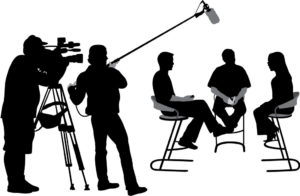By Chris Blose
Podcasts got their start back in 2004, in the Apple salad days of the iPod, but the medium found its market in the past five years. They appeal to communicators by blending the best of other formats — the in-depth storytelling of a magazine feature and the audio wizardry of radio.
Listenership numbers highlight their draw, too. One in every four Americans has listened to a podcast in the past month, according to data from Edison Research (tinyurl.com/podcon18). That’s up from just under one in 10 a decade ago. Listenership skews toward high-value demographics, too; 35 percent of monthly podcast listeners earn $100,000 or more per year.
Stats such as these lead to the inevitable question: Should you be podcasting?
The answer is a heavily qualified yes: Yes, if you have something unique to add to the market and the resources and commitment to produce something valuable. A quick scan of iTunes or Google Play reveals a glut of new and emerging podcasts in varied industries and categories, so before you hit record, make sure you have something to say and a smart way to say it.
If you do choose to podcast, start by defining your format. This may be the most important early step. Your format determines everything, from the time you’ll spend scripting and sourcing on the front end to the hours required for editing and post-production.
The good news: There are as many formats available to you as you can possibly dream up, from the classic interview to the serial drama. A few stand out as possible models for prospective podcasters.
The Gabfest
 From late-night TV to talk radio, the market for simple conversation has always been large. In the podcast world, fans will listen to a comedian such as Joe Rogan interview guests for hours at a time — with minimal production flourishes and little to no editing — largely because of the informality and naturalism of the setup.
From late-night TV to talk radio, the market for simple conversation has always been large. In the podcast world, fans will listen to a comedian such as Joe Rogan interview guests for hours at a time — with minimal production flourishes and little to no editing — largely because of the informality and naturalism of the setup.
Naturalism matters. The process and end result are quite a bit like producing a compelling Q&A for a magazine. Your finished product will be stronger if you don’t go in with a rigid checklist of questions, but rather allow a professional journalist or communicator to follow the conversation where it leads.
Take it from marketing visionary Mitch Joel, who has been producing the digital-minded Six Pixels of Separation podcast for 12 years now, drawing eclectic and impressive guests from Nicholas Carr to Jay Baer to Catharine Hays. “I wanted to capture the feeling of taking someone out to coffee and talking about a book I read or something I thought,” Joel says.
The beauty of the basic interview podcast is its simplicity. Still, that simplicity comes with its own set of needs.
You might choose this format if:
- You have a strong host in mind, such as an internal thought leader or experienced journalistic interviewer. This format shines brightest with
a host who knows how to discuss, not just
ask questions. - You have subject matter experts in mind who can speak eloquently, and at length, about the topics you want to discuss.
- You want to keep production time and costs to a minimum. This format requires minimal scripting (perhaps only an introduction), and the amount of editing is up to you. You can run conversations in their entirety if they’re interesting enough, or you can edit and tighten as you would with a magazine Q&A.
The Serial Narrative
 Mention podcasts in casual conversation, and people are likely to bring up Serial. This true-crime juggernaut, launched in 2014, draws listeners and hooks them via episodic storytelling. Podcast listeners need a reason to keep coming back, and serial narratives provide it. Readers want to know what happens next.
Mention podcasts in casual conversation, and people are likely to bring up Serial. This true-crime juggernaut, launched in 2014, draws listeners and hooks them via episodic storytelling. Podcast listeners need a reason to keep coming back, and serial narratives provide it. Readers want to know what happens next.
True crime is a natural fit for this format, but it’s by no means the only one. Gimlet Media found success telling business stories with Startup. And lest you think only known brands have the resources and capacity to weave these audio tales, give a listen to The Survivors from the National Fire Protection Association. This serial narrative tells the emotional story of a deadly fire and its lasting effects.
The serial narrative is engrossing and effective. It’s also on the opposite end of the spectrum from the gabfest in terms of the amount of time and effort required.
You might choose this format if:
- You have subject matter that lends itself to strong, scripted storytelling — and writers who can bring those episodic scripts to life.
- You have an experienced in-house multimedia team or are willing to partner with an agency that does. The serial narrative derives some of its power from audio cues, musical selection, and the pacing of edits — all skills that come with expertise and years of practice.
- You’re committed to the format. The common theme here is that serial storytelling works, as long as you’re willing to stick with it.
The High Concept
 If you want to stand out in a crowded field but don’t necessarily have the subject matter for a serial narrative, consider the conceptual approach.
If you want to stand out in a crowded field but don’t necessarily have the subject matter for a serial narrative, consider the conceptual approach.
Take Codebreaker from NRP, for example. There’s no shortage of technology-focused podcasts, but Codebreaker stands out for its overarching concept. Each season, the podcast creators work with one single driving question about technology, such as “Is it evil?” or “Can it save us?” The basic question leads to a deep episode-by-episode discussion of the technology we interact with everyday. As a bonus for astute listeners who follow along as each new episode is released, there’s an interactive element in the form of hidden codes
that unlock future, unreleased episodes
for listening.
Brands get in on the act, too. Cosmetics company Sephora has produced a podcast not about its products, but about the women who use them. Not just average users, either, but creative and entrepreneurial leaders. #Lipstories has carved its own niche with a clear concept that has only a slight connection to lipstick.
You might choose this format if:
- You want to develop something more creative and structured than simple interviews.
- You have a clear concept in mind that differentiates your podcast from others in your space.
- You’re willing to plan ahead, because hewing to a concept requires commitment.
None of the approaches above are set in stone, nor is this list comprehensive. There’s room for experimentation as well as mixing and matching the best ideas to suit your needs.
For instance, even if you choose to center your podcast around an interview or multiple interviews, you can still script a narrative lead to draw readers into each episode. You can still create varied segments that break up the episode and contribute to pacing, as well. That’s the approach we take with our own in-house podcasts at Imagination, It Takes Imagination and associationNation. Each is a mix of interviews, scripted segments, stats, and facts to break up the flow. Think of your podcast like a magazine, with a front of book to ease listeners in, a feature that goes deep, and a back of book that leaves readers craving more in the next episode.
That last note is important. As crucial as it is to find a format that’s right for you, it’s just as important to learn and grow with each successive episode. The pilot episode may feel like a struggle. You’ll find yourself cutting certain segments, trying new ones, and trimming and polishing as you go.
It comes down to planning and commitment. The audience for podcasts is there — and growing — if you’re willing to put in the time. Define what you want to say, then figure out how you want to say it.
Chris Blose is vice president, content at Imagination, where he develops content strategy and leads award-winning editorial teams. He also hosts two podcasts, It Takes Imagination and Trusteeship Radio. Connect via blose@pagesthemagazine.com.

Start Smart
Three bonus tips for early podcast planning:
- Define your business goals. If you’re trying to demonstrate thought leadership in your field, for example, a hybrid podcast centered around interviews might be a strong option. In turn, picking the right host and guests becomes especially critical. A company might want to feature internal thought leaders, whereas a membership association might want to put members front and center.
- Record a few episodes before you launch. Finding the right voice in a pilot episode can be a challenge. Producers often find a rhythm by the second or third episode. Producing multiple episodes before you launch allows for practice and refinement, and it gives prospective listeners more material to binge.
- Make it part of your marketing plan. Podcast distribution is a large-enough topic for its own article, but know this at the least: You’ll want to pull all the levers at your disposal to find listeners, from email to social to search optimization.

